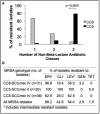Hospital-Associated Multidrug-Resistant MRSA Lineages Are Trophic to the Ocular Surface and Cause Severe Microbial Keratitis
- PMID: 32582610
- PMCID: PMC7283494
- DOI: 10.3389/fpubh.2020.00204
Hospital-Associated Multidrug-Resistant MRSA Lineages Are Trophic to the Ocular Surface and Cause Severe Microbial Keratitis
Abstract
Methicillin-resistant Staphylococcus aureus (MRSA) is a common cause of severe and difficult to treat ocular infection. In this study, the population structure of 68 ocular MRSA isolates collected at Massachusetts Eye and Ear between January 2014 and June 2016 was assessed. By using a combination of multilocus sequence typing (MLST) analysis, SCCmec typing and detection of the panton-valentine leukocidin (PVL) gene, we found that the population structure of ocular MRSA is composed of lineages with community and hospital origins. As determined by eBURST analysis of MLST data, the ocular MRSA population consisted of 14 different sequence types (STs) that grouped within two predominant clonal complexes: CC8 (47.0%) and CC5 (41.2%). Most CC8 strains were ST8, harbored type IV SCCmec and were positive for the PVL-toxin (93.7%). The CC5 group was divided between strains carrying SCCmec type II (71.4%) and SCCmec type IV (28.6%). Remaining isolates grouped in 6 different clonal complexes with 3 isolates in CC6 and the other clonal complexes being represented by a single isolate. Interestingly, major MRSA CC5 and CC8 lineages were isolated from discrete ocular niches. Orbital and preseptal abscess/cellulitis were predominantly caused by CC8-SCCmec IV PVL-positive strains. In contrast, infections of the cornea, conjunctiva and lacrimal system were associated with the MDR CC5 lineage, particularly as causes of severe infectious keratitis. This niche specialization of MRSA is consistent with a model where CC8-SCCmec IV PVL-positive strains are better adapted to cause infections of the keratinized and soft adnexal eye tissues, whereas MDR CC5 appear to have greater ability in overcoming innate defense mechanisms of the wet epithelium of the ocular surface.
Keywords: MRSA; Molecular Epidemiology; Ocular infection; Tissue tropism; biogeography of infections.
Copyright © 2020 Bispo, Ung, Chodosh and Gilmore.
Figures


Similar articles
-
Staphylococcus aureus from ocular and otolaryngology infections are frequently resistant to clinically important antibiotics and are associated with lineages of community and hospital origins.PLoS One. 2018 Dec 6;13(12):e0208518. doi: 10.1371/journal.pone.0208518. eCollection 2018. PLoS One. 2018. PMID: 30521630 Free PMC article.
-
[Infectivity-resistotype-genotype clustering of methicillin-resistant Staphylococcus aureus strains in the Central Blacksea Region of Turkey].Mikrobiyol Bul. 2014 Jan;48(1):14-27. Mikrobiyol Bul. 2014. PMID: 24506712 Turkish.
-
Genotyping of community-associated methicillin resistant Staphylococcus aureus (CA-MRSA) in a tertiary care centre in Mysore, South India: ST2371-SCCmec IV emerges as the major clone.Infect Genet Evol. 2015 Aug;34:230-5. doi: 10.1016/j.meegid.2015.05.032. Epub 2015 Jun 1. Infect Genet Evol. 2015. PMID: 26044198
-
The evolution of Staphylococcus aureus.Infect Genet Evol. 2008 Dec;8(6):747-63. doi: 10.1016/j.meegid.2008.07.007. Epub 2008 Jul 29. Infect Genet Evol. 2008. PMID: 18718557 Review.
-
A 6-Year Update on the Diversity of Methicillin-Resistant Staphylococcus aureus Clones in Africa: A Systematic Review.Front Microbiol. 2022 May 3;13:860436. doi: 10.3389/fmicb.2022.860436. eCollection 2022. Front Microbiol. 2022. PMID: 35591993 Free PMC article. Review.
Cited by
-
Interactions between staphylococcal enterotoxins A and D and superantigen-like proteins 1 and 5 for predicting methicillin and multidrug resistance profiles among Staphylococcus aureus ocular isolates.PLoS One. 2021 Jul 28;16(7):e0254519. doi: 10.1371/journal.pone.0254519. eCollection 2021. PLoS One. 2021. PMID: 34320020 Free PMC article.
-
Ocular Bacterial Infections: A Ten-Year Survey and Review of Causative Organisms Based on the Oklahoma Experience.Microorganisms. 2023 Jul 13;11(7):1802. doi: 10.3390/microorganisms11071802. Microorganisms. 2023. PMID: 37512974 Free PMC article.
-
Methicillin-Resistant Staphylococcus aureus Ocular Infection in Taiwan: Potential Role of Panton-Valentine Leukocidin Gene.Transl Vis Sci Technol. 2023 Apr 3;12(4):18. doi: 10.1167/tvst.12.4.18. Transl Vis Sci Technol. 2023. PMID: 37067364 Free PMC article.
-
Characterization of the resistome and predominant genetic lineages of Gram-positive bacteria causing keratitis.Antimicrob Agents Chemother. 2024 Mar 6;68(3):e0124723. doi: 10.1128/aac.01247-23. Epub 2024 Jan 30. Antimicrob Agents Chemother. 2024. PMID: 38289077 Free PMC article.
-
In Vitro Activity of Bacteriophages Against Ocular Methicillin-resistant S. aureus Isolates Collected in the US.Ophthalmol Ther. 2025 May;14(5):897-909. doi: 10.1007/s40123-025-01113-2. Epub 2025 Mar 12. Ophthalmol Ther. 2025. PMID: 40072828 Free PMC article.
References
-
- World Health Organization (WHO) Antimicrobial Resistance: Global Report on Surveillance. (2014).
-
- Kourtis AP, Hatfield K, Baggs J, Mu Y, See I, Epson E, et al. . Vital signs: epidemiology and recent trends in methicillin-Resistant and in methicillin-Susceptible staphylococcus aureus bloodstream infections - united states. MMWR Morb Mortal Wkly Rep. (2019) 68:214–9. 10.15585/mmwr.mm6809e1 - DOI - PMC - PubMed
Publication types
MeSH terms
Grants and funding
LinkOut - more resources
Full Text Sources
Medical
Research Materials

